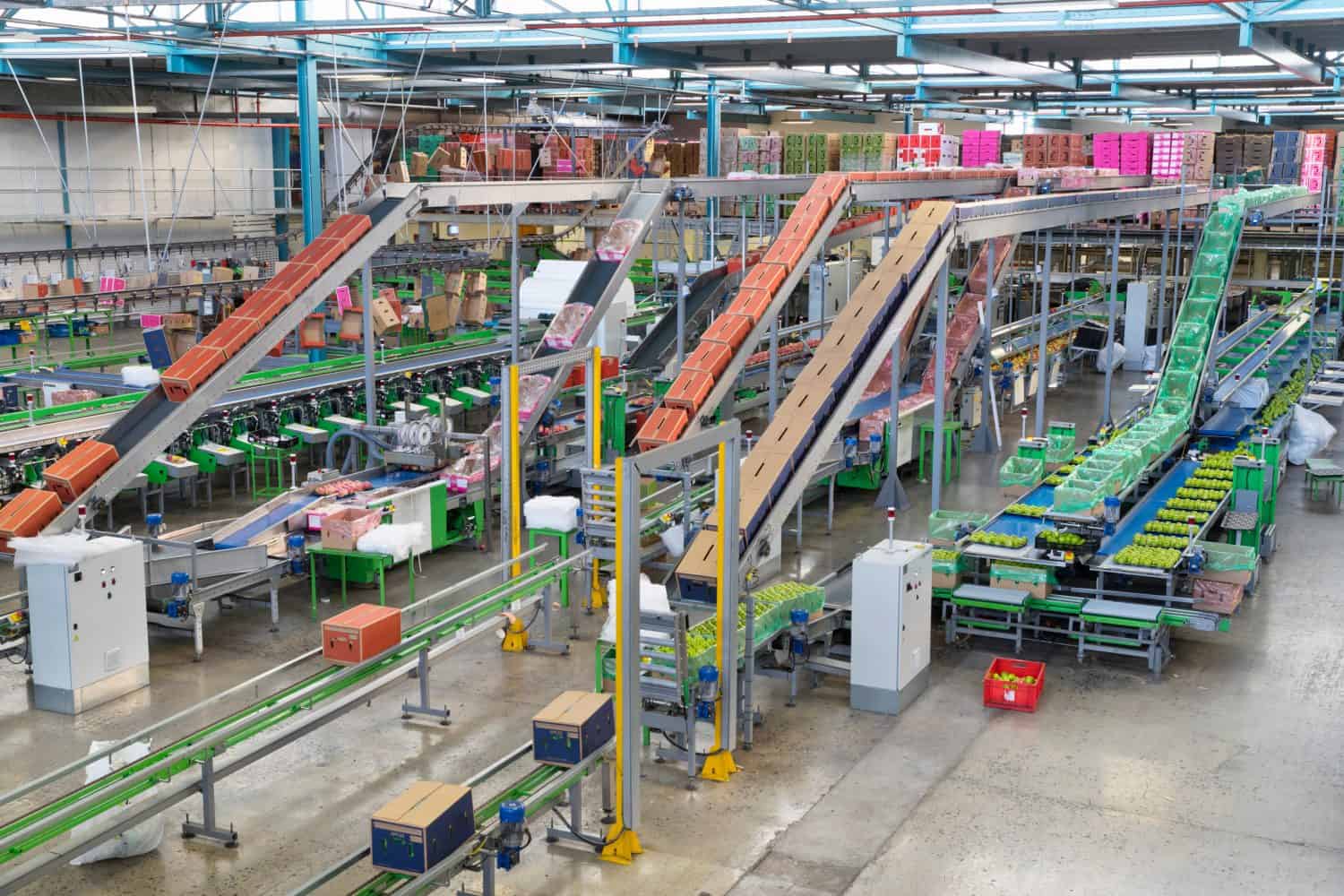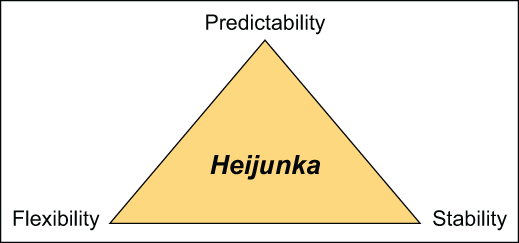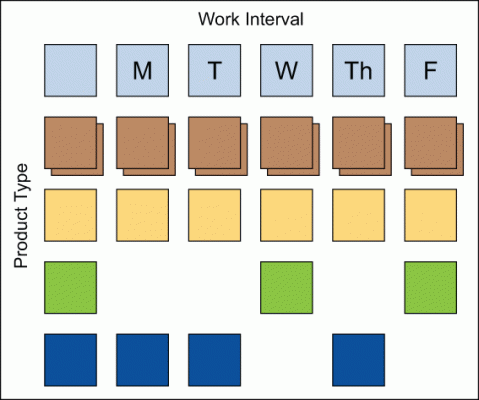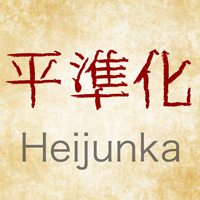
© Juice Flair/Shutterstock.com
Key Points
- Heijunka is a Lean technique for eliminating waste and refining production.
- It is typically implemented later on after production lines have been established.
- It runs counter to the concept of batch production, focusing on quality instead.
Heijunka (pronounced hi-JUNE-kuh) is a Japanese word that means “leveling.” When implemented correctly, heijunka elegantly – and without haste – helps organizations meet demand while reducing while reducing waste in production and interpersonal processes.
According to many Lean experts, heijunka is better achieved as a later-stage implementation in a Lean organization, long after value streams have been identified and solidified, and refined when Lean philosophy and legacy are already deeply embedded into process and materials cycles.
What Is Heijunka?
Here is how Lean Lexicon, 4th Edition defines heijunka: “Leveling the type and quantity of production over a fixed time. This enables production to efficiently meet customer demands while avoiding batching and results in minimum inventories, capital costs, manpower, and production lead time through the whole value stream.”
Batching is what mass producers do. For example, Ford Motor Company when it first started was a mass producer. Company founder Henry Ford was fond of saying that customers could have any color Model A they wanted, as long as it was black.
Daniel T. Jones, founder and chairman of the Lean Enterprise Academy, writes: “Years ago, Toyota reached the counter-intuitive conclusion that this [batching] is a bad idea. It reasoned that no production system can be continuously responsive to gyrating orders without suffering from mura (unevenness in productivity and quality), and muri (overburden of machines, managers, and production associates). And mura and muri together create muda (waste).”

Leveling by Volume or Type
Let’s look at leveling volume. Say a hat producer receives orders for 500 of the same hat per week: 200 orders on Monday, 100 on Tuesday, 50 on Wednesday, 100 on Thursday, and 50 on Friday. Instead of trying to meet demand in sequence of the orders, the hat producer would use heijunka to level demand by producing an inventory of 100 hats near shipping to fulfill Monday’s orders.
Every Monday, 100 hats will be in inventory. For the rest of the week, production will make 100 hats per day – a level amount. The inventory might look a little suspicious to Lean purists, but it has its fans – it is the method the Toyota Production System uses today.
What if the situation involves multiple types of hats? Consider that orders are being placed for hat models A, B, C, and D. A mass producer will want to minimize waste around equipment changeovers. Its production schedule will look something like this: AAAAABBBCCDD.
But what if a buyer decides at the last minute that orders of A need to be B instead? What if order volumes for A suddenly drop off the map and orders for C begin to increase?
A mass producer might be desperate to find the capacity to make more C while its A capacity sits. To avoid such waste, a heijunka production schedule might look like AABCDAABCDAB, with emphasis placed on efficient changeover times and buffer inventories that meet the demand for more popular items.
In 2004, reporter Jonathan Fahey wrote in Forbes about Toyotas USA’s efforts to allow dealers to change product attributes, such as color, from sales floor computers by looking at what was queued up in the factory – crushing production-related lead times because they had achieved highly efficient changeover times through heijunka.
Slowing Down
While it can be tempting to go full steam ahead with production, that isn’t the best idea. You want to create quality products, rather than mass-producing single products. Further, this is one Lean concept that hones in on the reduction of waste. As such, you’ll find surprising benefits to adopting this principle, such as cost savings down the road.
Production Meets Demand with Heijunka
Before talking about putting heijunka in place, let’s consider how Lean expert Michael Ballé describes the importance of heijunka to Lean organizations: By producing every product during every relevant timeframe, lead time is reduced and the business is closer to meeting “real” demand.
That is the essence of heijunka: pulling production in tight and cozy with demand. If all product types are created (and stored as necessary) throughout a year, flexibility is increased, the hats should all sell (perhaps not immediately, but eventually) and production will be able to meet peak demand periods.
What’s the catch? Changeover time. Heijunka depends significantly upon putting a percentage of capacity (Ballé recommends 10 percent) into changeover flexibility. “If you want to make every product every day, which is kind of the Lean first goal, you need to reduce changeover time accordingly,” Ballé writes.
Demand forecasts are often not quite right, and sometimes completely wrong. Increasing changeover flexibility and efficiency protects a production line from demand ambushes set up by the forecasts themselves.
Implementation
The frame of any heijunka implementation should begin with takt time and end with a heijunka box.
Takt time is the time it takes to complete a product to meet customer demand. It represents the rate at which customers buy a company’s product and at the end of a day or a week, it will show how much of product A, B, C, or D needs to be shipped (or finished – as heijunka is not just for manufacturing; it can be used in front and back office settings – in any setting that has a discernible supply and demand).
A heijunka box (it can also be a wheel or board) is a simple visualization of production using kanban cards to signal production according to a specified interval of work (e.g., per day). It is used by production staff on the floor and is highly regarded in visualizing processes.

Other Useful Tools and Concepts
Lean has plenty of concepts to apply to your organization. One of the more nebulous aspects of any methodology is understanding the nomenclature and jargon. When it comes to a term as innocuous as quality, you might think you’ve got the definition squared away. However, our guide focuses in on what quality means in the context of Lean Six Sigma.
Additionally, if you’re starting a new business, the opening months can be tough. However, if you start at the ground floor by fostering a nimble and quick-thinking organization, you’re in for a treat. As such, the first step is implementing this line of thinking culturally before focusing on production.
Core Concepts to Guide Heijunka Implementation
Keeping in mind the core concepts of heijunka will help keep a company heading in the right direction.
- Takt time: The time it takes to finish a product to meet customer demand; can be thought of as the customer buying rate. It is the guidance for the entire heijunka implementation.
- Volume leveling: Manufacture at levels of long-term average demand and keep a buffer inventory proportional to variability in demand, stability of production process, and shipping speed.
- Type leveling: Essentially, make every product every day and reserve capacity for changeover flexibility; use a heijunka box to visualize the production flow and schedule.
- Heijunka box: A working diagram of type leveling and production schedule.
- Work slowly and consistently: Taiichi Ohno, founder of the Toyota Production System, says it best: “The slower but consistent tortoise causes less waste and is much more desirable than the speedy hare that races ahead and then stops occasionally to doze. The Toyota Production System can be realized only when all the workers become tortoises.”
- Changeover time: The efficiency of changeover is the fulcrum of heijunka; narrowing changeover times helps tighten the value stream between supply and demand.
- Buffer inventory: Having some product ready to ship at the beginning of each production cycle is essential to smoothing production and leveling demand at consistent rates and quality so that resource waste is minimized on the line.
- Type standardization: By manufacturing one product or service a day, knowledge can be more readily shared across types to benefit every process.
The image featured at the top of this post is ©Juice Flair/Shutterstock.com.
